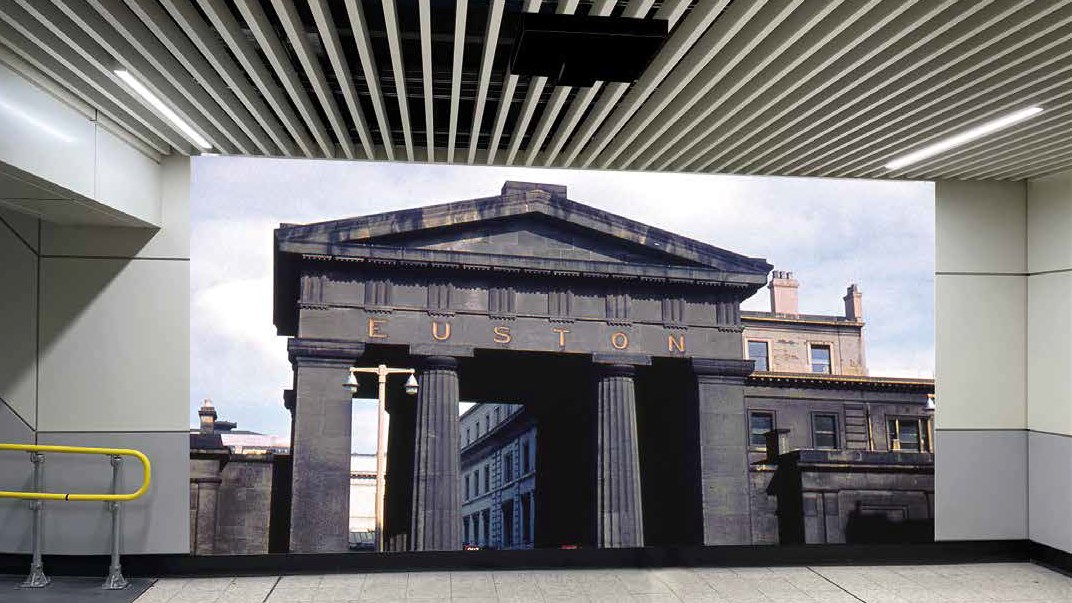Wednesday 1 Jun 2022
Video installation pays tribute to Euston station's former Doric Arch
- Region & Route:
- North West & Central
- | North West & Central: West Coast Mainline South
A new video projection screen has been unveiled to remember a long-lost architectural icon at London Euston station.
Network Rail was awarded a grant from the Railway Heritage Trust to create a modern reminder of the infamous Doric Arch near to where it originally stood.
When built in 1838*, it dominated the entrance to Euston station - the world’s first inter-city railway terminus - and was the largest neo-classical arch ever built in Britain.
But when British Rail embarked on its electrification of the West Coast main line in 1959, the arch was right in the middle of where a new modern and much bigger station needed to be built**.
Despite great outcry and protests from architects and heritage groups, the Doric Arch was demolished in 1961 to make way for the modernist station here today.
Where the arch originally stood is in fact deep in the bowels of the current station - not beside the two lodge buildings which still exist on Euston Road – as is often thought.
Instead, it was where the newly refurbished ramp to platforms 8-11 is now, behind the current departure boards on the main concourse.
Now a projection screen and vinyl graphics will show images to passing passengers to commemorate what once was there before.
Tim Shoveller, Network Rail’s North West and Central region managing director, said: “I hope passengers will enjoy this new art installation which creates an important link to the past and will inspire people to learn more about the fascinating history of Euston and its integral part in railway history.
“Now in the 21st century Euston is once again at the centre of the railway’s future with HS2, Britain’s new zero-carbon inter-city railway being built. I’m proud that 185 years since Euston first opened - this installation now reminds people where the story started.”
Andy Savage, executive director at the Railway Heritage Trust, said: "The decision to demolish the Euston Arch totally, rather than relocate it as originally proposed, was one of the greatest mistakes of 1950s and 60s railway architecture, although happily its sister structure at Curzon Street in Birmingham still shows us its style and size. The RHT is delighted to have been able to propose and fund this scheme, which both shows clearly where the arch was located, and commemorates a great structure.
"We thank Network Rail for including this in its scheme to improve access to platforms 8-11, and are delighted that its completion coincides with Her Majesty Queen Elizabeth's Platinum Jubilee, given that the original station Arch was opened within a couple of weeks of Queen Victoria's accession."
For more information of the history of Euston station visit: https://www.networkrail.co.uk/who-we-are/our-history/iconic-infrastructure/the-history-of-london-euston-station/
Notes to Editors
* Euston was the first terminus station to be built in the world and it opened in 1837 as the terminus for the London & Birmingham Railway. The arch was designed by Philip Hardwick in the classical Greek Doric style with four columns made from Yorkshire stone.
**The Victorian station was demolished in 1961-62, and the existing station was opened by Queen Elizabeth II on 14 October 1968.
Contact information
Passengers / community members
Network Rail national helpline
03457 11 41 41
Latest travel advice
Please visit National Rail Enquiries
Journalists
Network Rail press office - North West & Central Region
0330 854 0100
NWCmediarelations@networkrail.co.uk
About Network Rail
We own, operate and develop Britain's railway infrastructure; that's 20,000 miles of track, 30,000 bridges, tunnels and viaducts and the thousands of signals, level crossings and stations. We run 20 of the UK's largest stations while all the others, over 2,500, are run by the country's train operating companies.
Usually, there are almost five million journeys made in the UK and over 600 freight trains run on the network. People depend on Britain's railway for their daily commute, to visit friends and loved ones and to get them home safe every day. Our role is to deliver a safe and reliable railway, so we carefully manage and deliver thousands of projects every year that form part of the multi-billion pound Railway Upgrade Plan, to grow and expand the nation's railway network to respond to the tremendous growth and demand the railway has experienced - a doubling of passenger journeys over the past 20 years.
Follow us on Twitter: @networkrail
Visit our online newsroom: www.networkrailmediacentre.co.uk

